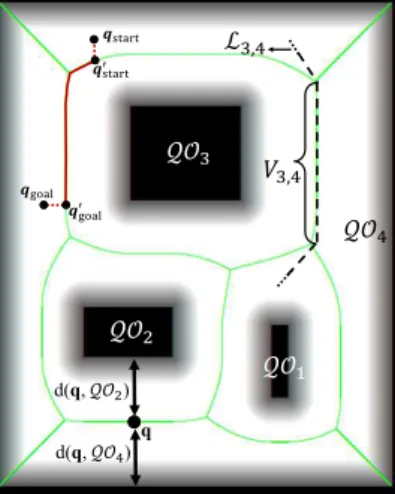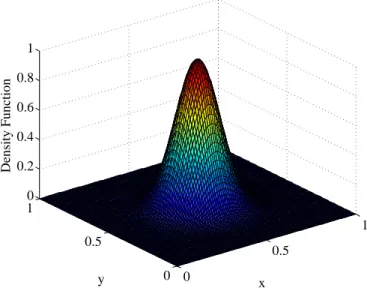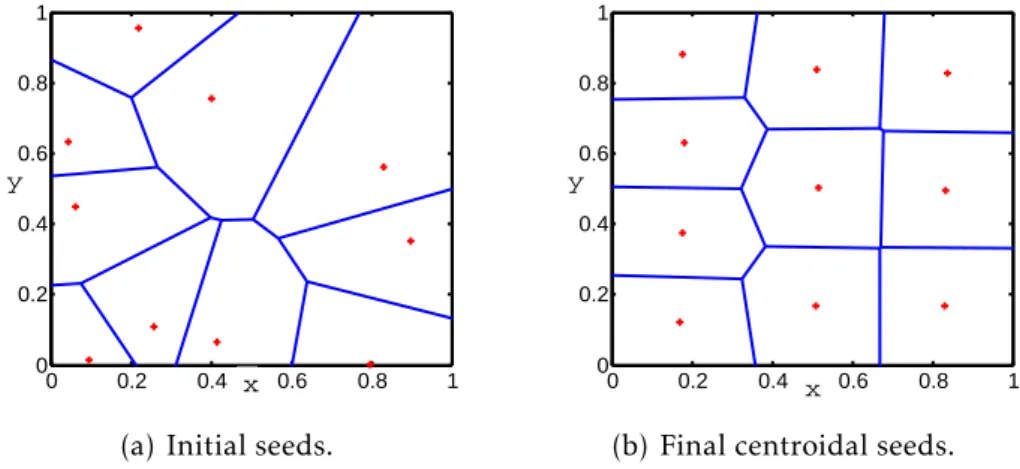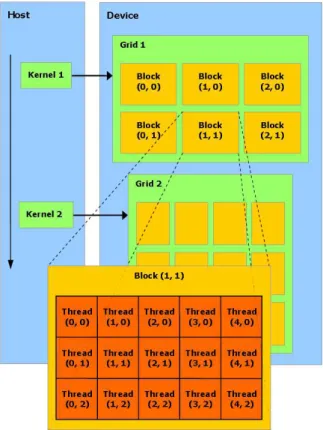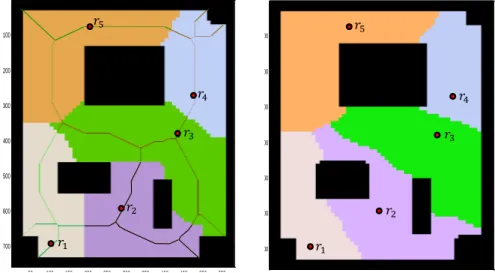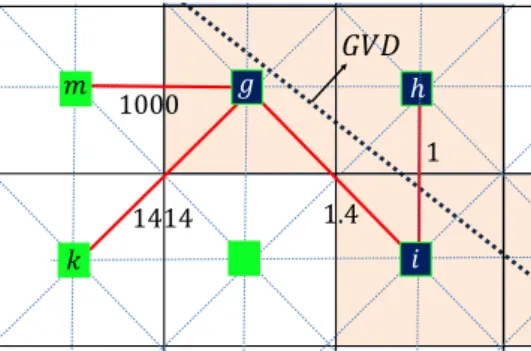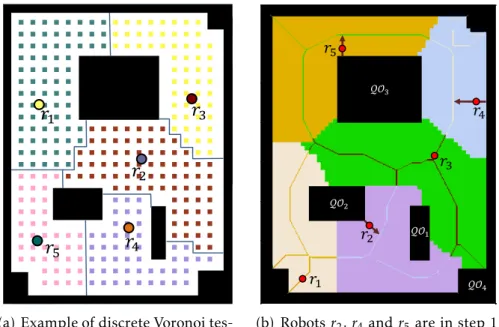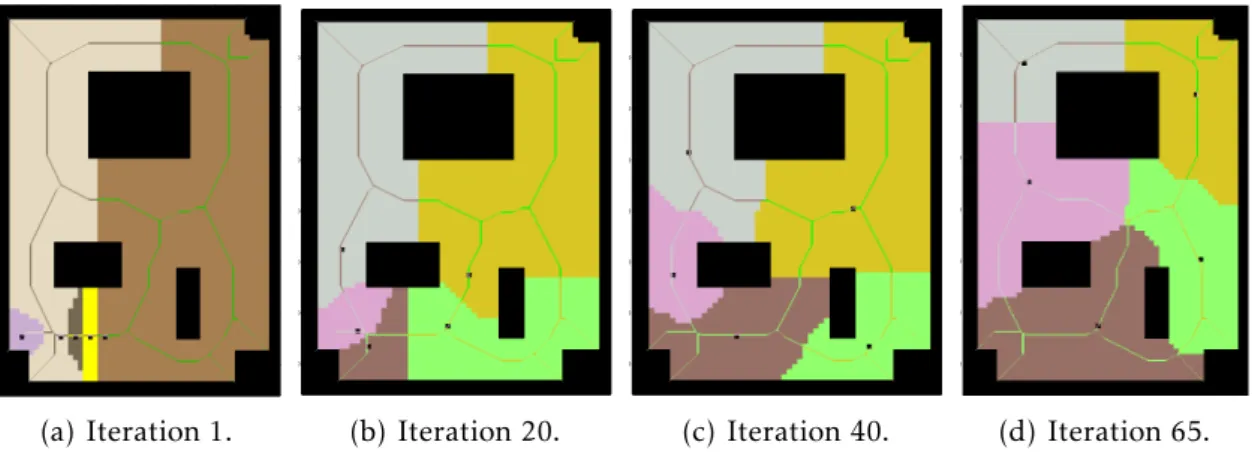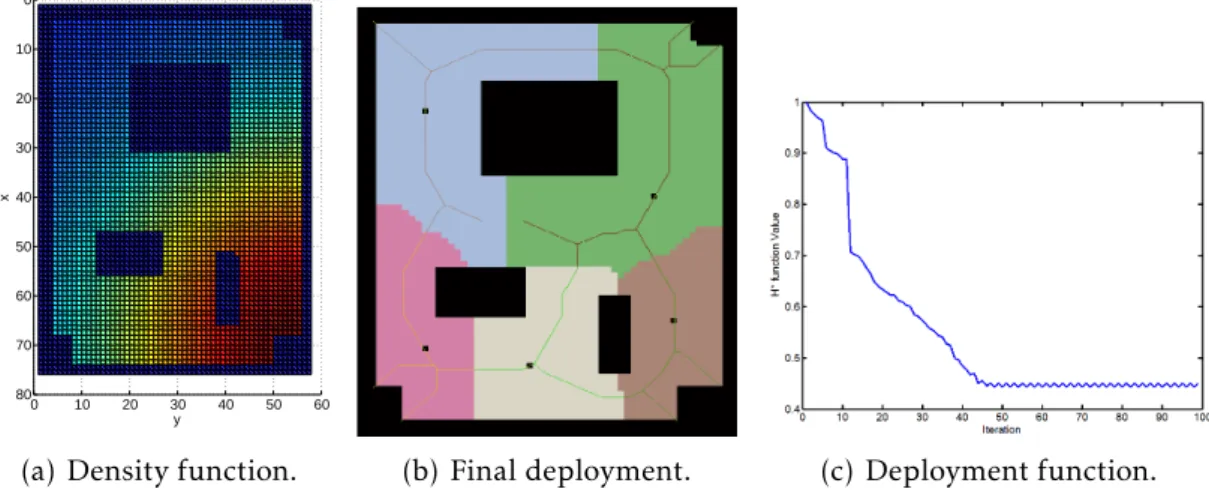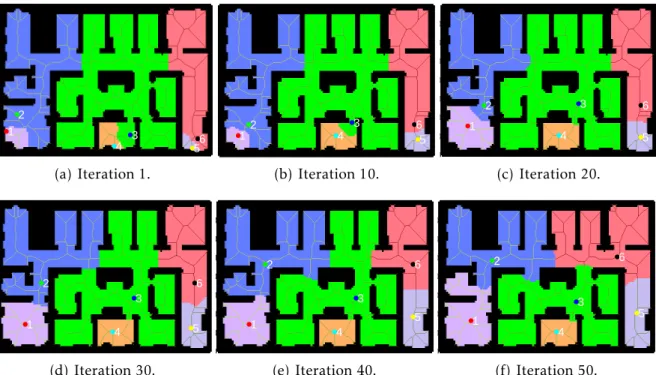Computer System and Robotic Laboratory (CORO) Electrical Engineering Department
Federal University of Minas Gerais (UFMG)
Av. Antônio Carlos, 6627, CEP 31270-901, Belo Horizonte, MG, Brasil Phone: +55 3499-3470
New Strategies for Multi-Robot
Coordination in Optimal Deployment
Problems
Reza Javanmard Alitappeh
PhD thesis submitted to the Graduate Program in Electrical Engineering of the Federal University of Minas Gerais in fulfillment of the requirements for the degree of Doctor of Electrical Engineering.
Advisor: Prof. Dr. Luciano Cunha de Araújo Pimenta Department of Electronic Engineering at UFMG
Co-advisor: Prof. Dr. Luiz Chaimowicz
Computer Science Department at UFMG
Dedication
I would like to dedicate this to my dear wifeKossar. Thank you very much for all of your support and encouragement while I wrote this document. It is also dedicated to my de-votedfather and mother, who taught me to be patient, and to have perseverance to accomplish the most challenging task of all my life.
Acknowledgment
First, I am merciful of God, for giving me strength to finish this work.
I would like to express my sincere gratitude to my advisor Prof. Luciano Pimenta
who has been the ideal thesis supervisor. His sage advice, motivation, insightful
criti-cisms, and patient encouragement aided the writing of this thesis in innumerable ways.
Also my co-advisor Prof. Luiz Chamowicz, who guides me to find the right line in my
PhD.
Besides my advisor and co-advisor, thanks to Prof. Guilherme Pereira who was
always available to answer my inquiries and offered me devices and equipments of
robotics lab (CORO). Moreover, many thanks for his help in development of the
the-ory that allows us to deploy multi-robot system in topological map (Chapter6). Also
one of his undergrad studentArthur Araujowho developed the robot control package
that was used in our simulation and real robot experiment in Chapter6.
My sincere thanks also goes to Prof. Frederico Guimaraesfor all his supports. As a
kind friend, he made me forget loneliness in my living time in Brazil.
Many thanks to the committee members in my defense: Prof. Alexandre Ramos,
again Prof. Guilherme Pereira, Prof. Bruno Adorno, and Prof. Vinicius Mariano.
We gratefully acknowledge support fromCNPq, CAPES, andFAPEMIG.
Last but not least, I thank my colleagues in CORO, VerLab and MACRO and friends
in Brazil for all their support.
Contents
Contents vii
Abstract xi
List of Figures xiii
List of Tables xv
List of Algorithms xvii
List of Symbols xix
List of Abbreviations xxiii
1 Introduction 1
1.1 Motivation and Contributions . . . 2
1.2 Document Organization . . . 5
2 Background 7 2.1 Graph (Dijkstra Algorithm) . . . 7
2.2 Generalized Voronoi Diagram (GVD) . . . 8
2.3 Voronoi Tessellation . . . 10
2.4 Locational Optimization Based Deployment . . . 11
2.4.1 Problem Definition . . . 11
2.4.2 p-Median Problem . . . 15
2.5 GPU and CUDA . . . 16
2.5.1 Software Model: . . . 16
2.5.2 Hardware Model: . . . 21
2.5.3 New CUDA Hardware Model . . . 22
3 Related Work 23 3.1 Multi-Robot Deployment . . . 23
3.1.1 Multi-Robot Deployment in Continuous Space . . . 25
3.1.2 Multi-Robot Deployment in Discrete Space . . . 28
3.2 GPU Based Graph Search and CVT . . . 29
4 Robot safe deployment 33 4.1 Introduction . . . 33
4.2 Safe Deployment. . . 33
4.2.1 New Metric . . . 34
4.2.2 Collision Avoidance Between Robots . . . 36
4.3 Proposed Solution . . . 38
4.3.1 Discrete Approximation . . . 38
4.3.2 Distributed Algorithm . . . 41
4.4 Results . . . 46
4.4.1 Simple Map . . . 46
4.4.2 Office-like Environment . . . . 48
4.5 Conclusion . . . 50
5 New Multi-Robot Deployment Algorithm 53 5.1 Introduction . . . 53
5.2 Proposed Method . . . 53
5.2.1 Discrete Approximation and Graph Representation . . . 54
5.2.2 Deployment Function. . . 57
5.2.3 Robot Node Neighbors . . . 58
5.2.4 Distributed Algorithm . . . 60
5.3 Discrete Implementation on GPU . . . 67
ix
5.3.2 Parallel MSSP algorithm . . . 70
5.3.3 CPU VS GPU . . . 76
5.4 Implementation Result . . . 77
5.4.1 Simple Map . . . 77
5.4.2 Office-like Environment . . . . 79
5.4.3 Real Robot Experiment . . . 83
5.5 Conclusion . . . 86
6 Deployment in Topological Map 87 6.1 Introduction . . . 87
6.2 Problem Statement . . . 88
6.3 Methodology . . . 89
6.3.1 Topological Map Representation . . . 90
6.3.2 Multi-Robot Deployment. . . 94
6.3.3 Analysis . . . 97
6.3.4 Robot Control . . . 102
6.4 Implementation Results . . . 105
6.4.1 Simulation Results . . . 105
6.4.2 Real Robot Experiments . . . 109
6.5 Conclusion . . . 111
7 Conclusion and Future Directions 113
Abstract
In recent years, multi-robot systems have played an increasing role in many real world applications thanks to its flexibility, robustness, and reduced cost when com-pared to single-robot solutions. One of the important challenges in this field is to efficiently distribute and coordinate a team of robots over the environment, so that
de-sired tasks can be properly performed by this team. In this work we extend previous methods on multi-robot deployment in order to improve safety, convergence, applica-bility and computational time. In the first extension, we propose a new strategy based on the locational optimization framework. Our approach models the optimal deploy-ment problem as a constrained optimization problem with inequality and equality constraints. In order to consider the generation of safe paths during the deployment or in future excursions through the environment, this optimization model is built by incorporating: the classical Generalized Voronoi Diagram (GVD); and a new metric to compute distance in the environment. GVD is commonly used as a safe roadmap in the context of path planning, and the new metric induces a new Voronoi parti-tion of the environment. Furthermore, inspired by the classical Dijkstra algorithm, we present a novel efficient distributed algorithm to compute solutions in complicated
en-vironments. A new distributed multi-robot deployment algorithm is proposed as the second extension. By relying on the novel strategy of continuous movement in a dis-crete approximation of the environment, the convergence of the algorithm is proven. Furthermore, as our third extension, we present a new implementation of the pro-posed deployment algorithm. When the number of robots is large or the region corre-sponding to each robot is large, the computational time of the locational optimization framework might be high. Thus, a new algorithm is proposed, which is able to run in parallel setup. CUDA is used as a platform for running the proposed algorithm. In our fourth extension, we propose a new discrete deployment strategy which prop-erly works on a topological framework. This framework represents environments as a topological map, which transforms the original two or three-dimensional problem into a one-dimensional, simplified problem, thus reducing the computational cost of the solution. It also makes the new deployment model suitable for the environments that can be represented by a topological map, such as block-shape cities or corridor based buildings i.e. departments in universities, hospitals, governmental offices, etc.
It is important to mention that this combination of our discrete deployment with the
List of Figures
1.1 Comparison of centralized and decentralized system.. . . 2
1.2 Deployment problem in a real application. . . 3
2.1 Example of GVD (green line). . . 9
2.2 A set of sites (pi) with corresponding Voronoi regions(Vi). . . 11
2.3 Euclidean and geodesic metric. . . 12
2.4 Example of density function in a 2D environment. . . 13
2.5 Example of CVT with 10 points as sites or seeds. . . 14
2.6 An example ofp-median problem . . . 15
2.7 Threads in memory (NVIDIA, 2007). . . 17
2.8 CUDA architecture. . . 18
2.9 CUDA Hardware Model, (NVIDIA, 2007). . . 20
2.10 New architecture in CUDA 6, NVIDIA (2014). . . 22
3.1 Deployment of four robots . . . 25
4.1 New metric. . . 35
4.2 Difference between geodesic and new metric. . . . . 36
4.3 Difference between geodesic and new metric Voronoi tessellation. . . . 37
4.4 Equality and inequality constrains. . . 38
4.5 Discretization and graph representation. . . 39
4.6 Graph representation. . . 40
4.7 Robots motion. . . 42
4.8 Discrete Voronoi tessellation and robots movement. . . 45
4.9 Input map and density function.. . . 47
4.10 Running the proposed algorithm for five robots. . . 47
4.11 H∗function for the first example. . . 47
4.12 Simulation with a different density function.. . . . 48
4.13 Office-like map with GVD . . . . 48
4.14 Density function. . . 49
4.15 Snapshots of running the algorithm . . . 49
4.16 Result of running the algorithm on office-like map. . . . . 50
5.1 Discrete approximation of the environment. . . 55
5.2 Edge modification in neighbor cell. . . 56
5.3 Assumption on obstacles. . . 57
5.4 Computing Voronoi region on a dynamic graph. . . 58
5.5 Graph neighbor nodes of cellsi. . . 59
5.6 Neighboring in the new strategy. . . 59
5.7 Projecting gradient vector. . . 62
5.8 Thread pool. . . 67
5.9 Compact adjacency list and the pattern. . . 69
5.10 Customized compact adjacency list. . . 70
5.11 Mask array. . . 72
5.12 Conflict in parallel implementation. . . 74
5.13 Running parallel wavefront algorithm. . . 75
5.14 Input descretized map. . . 78
5.15 Snapshot of a simulation run. . . 80
5.16 Final trajectory and cost function. . . 81
5.17 Input map and corresponding density function. . . 81
5.18 Iterations of running the new deployment method. . . 82
5.19 Final trajectory and cost function in Office-like Map. . . . . 82
5.20 E-puck robot and robot model.. . . 83
5.21 Initial location of robots in the map. . . 84
5.22 Robots motion during the experiment. . . 85
6.1 A sketched map . . . 89
6.2 Discretizated map and directions. . . 91
6.3 Corresponding graph of the map in Fig. 6.2. . . 92
6.4 Moving between nodes. . . 92
6.5 Density function represented in graph. . . 93
6.6 Voronoi subgraph. . . 98
6.7 Robot model. . . 103
6.8 Robot system in high-level. . . 106
6.9 The map of a neighborhood in New York . . . 106
6.10 The density function. . . 107
6.11 Result of partitioning the input map by the proposed method. . . 108
6.12 Simulation result. . . 108
6.13 The map used in real robot experiment. . . 110
List of Tables
3.1 Different classes of deployment approach. . . . . 24
5.1 Notations. . . 54
5.2 Result of first test. . . 76
5.3 Result of second test on two graphs.. . . 77
5.4 Result of running Dijkstra algorithm on grid graph. . . 77
6.1 Set of commands and costs in the simulation. . . 107
6.2 Comparison ofHin different methods. . . . 107
6.3 Commands applied on robots in the real experiment. . . 111
List of Algorithms
1 Dijkstra algorithm. . . 8
2 Distributed algorithm of roboti . . . 41
3 Modified Dijkstra . . . 44
4 Deployment algorithm . . . 61
5 MSSP() . . . 65
6 MSSP_CUDA . . . 71
7 KERNEL1 . . . 73
8 KERNEL2 . . . 75
9 Distributed controller . . . 95
10 FunctionFind_next_best_node(). . . 97
List of Symbols
Πi(GV D) Projection of the pointpi onto the GVD
η First vertex neighbor nodes of robot
∇H Gradient ofHfunction
Ω Representing the environment
ω Angular velocity
∂Ω Boundary of the environment
∂Vi Boundary of the Voronoi regioni
φ Distribution density function
ai Radius of disk roboti
Co The cost map between robots and all nodes in a graph
C andC Cost/weight matrix or cost function in a graph
Cs Cost/weight of static nodes
Cd Cost/weight of dynamic nodes
c(i,j) andcij Cost between the centers of the cellsi andj or an edge
d(i,j) Distance between two nodei andj
d∗(i,j) Minimum distance between two nodei andj
E Set of edges in a graph
Es Set of static edges
Ed Set of dynamic edges
FVi Free Voronoi regioni
G Graph
GGV Di∗ Corresponds to the set of grid cells so thatd∗(P(q),P(pi))
is less thand∗(P(q),P(pj)),∀j,i
g(q,pi,G) Geodesic distance between nodesqandpi in the graphG
gi Voronoi subgraph
h Equality constraint
H,H∗,H0 Deployment function (cost function)
I Set of robot commands that links two edges
Li,j Bisector between two Voronoi regioni andj
M Number of source (robot)
Ma A mask array for controlling wavefront algorithm
np Number of Search Points
N and|V | Number of node in graph
NG A set of graph neighbor nodes
NG(pi) Graph neighbor nodes of nodepi
nid Index of the neighbor of a node
o Voronoi tessellation map
P={p1,· · ·,pM} Configuration ofM robots
pi Configuration of roboti (vector)
pi Nodei of graph or robot position in graph
p∗i Centroid of a Voronoi cell
˙
pi Velocity
pi∗ Next best node to go for roboti PathInit_T o_GV D Path from the initial point to GVD
PathGV D_T o_GV D Path from a point on GVD to another point on GVD
PathGV D_T o_Goal Path from GVD to the goal point
QO Set of obstacle
Qf ree Free configuration space
xxi
q Configuration of a point in space
qc Center of distribution function
R={r1,r2,· · ·,rM} Index ofMrobots
R={r1,r2,· · ·,rk} A subset ofR(R ⊆R), in which robots are neighbors
Ri A set of neighbor robots with shared Voronoi boundariesVi
RiVGV D Position of neighbor robots which already lye onVGV D
ri Index of roboti
s Starting vertex in a path
Uc Temporary memory for cost updating
ui Control input
V Set of nodes in a graph
Vs Static nodes
Vd Dynamic nodes
Vi Voronoi regioni
v Linear velocity
vs Source node
VGV D Set of grid cells that contain GVD curves
V Set of vertices (nodes)
Wi Tessellation regioni
W1 andW2 Coefficient of the new metric
¯
w A constant related to the integral element of area
x0andy0 Center of Gaussian function
Xij Binary variable for edge [ij] in MILP model
[xy] The edge between nodesxandy
y Inequality constraint
List of Abbreviations
APSP All-Pair Shortest Path
AUV Autonomous Underwater Vehicle
CUDA Compute Unified Device Architecture
CVT Centroidal Voronoi Tessellation
GPU Graphics Processing Unit
GPGPU General Purpose Graphic Processing Unit
GVD Generalized Voronoi Diagram
GGVD Geodesic Generalized Voronoi Diagram
MSSP Multi Source Shortest Path
MILP Mixed Integer Linear Programming
MW Multiplicative Weighted
SSSP Single Source Shortest Path
tid Thread ID
TSP Traveling Salesman Problem
UAV Unmanned Aerial Vehicle
VD Voronoi Diagram
VMW Visibility-aware Multiplicative Weighted
WSN Wireless Sensor Network
Chapter 1
Introduction
A set of autonomous sensors, which is a networked system that can communicate
and use sensing data gathered mutually by each spatially distributed sensor node, is
known as a Wireless Sensor Network (WSN) (Suzuki and Kawabata,2008). Moreover,
according to (Bullo et al.,2009), a system composed of a group of robots that sense
their own positions, exchange messages following a communication topology, process
information, and control their motion is called a robotic network. One can find several
applications for this type of system such as surveillance, sensing coverage,
environ-ment monitoring, search and rescue, etc. In a multi-robot system, agents might
co-operate to accomplish a single task much more efficiently than a single-robot system.
Also, in the case of a complex task, usually a group of robots can reach the result much
faster. Furthermore, when robots are able to sense the environment independently,
after fusing the captured data the effect of a failure in some data from any
individ-ual will not have a big impact due to the probability of having redundant information
provided by other agents.
There are two common types of strategies to coordinate a group of robots. First,
when a leading robot or central computer collects the state information of all the other
robots, the tasks and the environment to determine the appropriate motion of each
individual robot, this is called centralized strategy. In this case, the difficulty is in
adapting to the dynamic environment and to accommodate a large number of robots.
The second strategy is called distributed or decentralized in which each robot can
com-pute its own decision according to its states, its local environment and its interactions
with nearby robots and other entities. One benefit of this distributed system is the
possibility of reduction of the complexity of the involved algorithms such as in the
1.1indicates the communication of robots in both strategies.
(a) A centralized robotic system. All robots are contacting the server robot.
(b) A decentralized robotic system. Robots are contacting some neighbor robots in the network.
Figure 1.1: Comparison of centralized and decentralized system.
In some applications of robotic networks, an important question to be answered is:
where should each robot be placed in the environment? In the present work we show
distributed solutions to this problem which is referred as the deployment problem
byBullo et al.(2009).
In this topic, the solution is distributed in the sense that each agent depends only on
information from a small set of other agents, called neighbors, to compute its actions.
Besides, this set of neighbors is dynamic since it might change as the system evolves.
As pointed byCortes et al.(2004), this allows for scalability and robustness.
1.1 Motivation and Contributions
Due to the vast number of applications of multi-robot systems and particularly
the usage of autonomous deployment strategies, in this thesis we investigate different
aspects of this research topic.
We are interested in finding optimal deployment configurations for a group of
robots. A configuration can be considered as optimal if it is a minimizer of a
func-tional encoding the quality of the deployment. The quality of deployment is usually
related to the time of response of the network after an event that needs servicing
1.1 Motivation and Contributions 3
event and the agent capabilities (speed, sensor field of view, etc). In order to minimize
the distance between agents and events, our approach applies the idea of partitioning
the environment into subregions which are then assigned to specific agents. Therefore,
each agent is responsible for attending the events in its corresponding subregion.
Figure 1.2: In this example three firefighter cars must be located over the map in such a way that in case of fire in their dedicated region, they respond in minimum time.
An example in Fig. 1.2 considers an application of determining the best station
for rescue cars in a city such that they reach the intended area in minimum time. In
locational problems, we usually have the objective of finding the best positions to place
entities such as: cars, robots or any kind of facility. Given the importance of
multi-robot deployment problem and also the fact that it is a new research topic, several
researchers are currently interested in developing new efficient strategies which are
amenable to real world implementation. In this thesis we tried to address shortages
found in previous methods and also extend some works in the literature.
Contribution
In this work, our contributions are divided into 3 main parts which are listed below:
• First, we extend the previous works on multi-robot deployment by considering
safety in robots motion. In the new technique GVD is employed as a roadmap,
so that robots are forced to keep moving over the GVD. To apply this constraint
in robots path planning, we develop a new metric, which computes the shortest
the robots during deployment. Moreover, in order to compute next actions of the
robots, we developed a new efficient algorithm. Simulation results validates the
applicability of the proposed method.
• A new method for deploying a team of robots by considering a continuous
move-ment of robots in a discrete representation of the environmove-ment is proposed. This
work defines a new strategy to choose the next action, such that the cost
func-tion never increases. It makes possible to address the problem of convergence
of previously proposed methods such as (Bhattacharya et al., 2013c). We also
propose a new efficient parallel implementation of our algorithms. In particular,
CUDA based discrete implementation is applied to speed up the graph search
algorithm. Simulation and real robot experiments testify the performance of this
extension in Chapter5.
• While the cited deployment techniques focused on environments with two or
three dimensions represented by geometric maps, we derived a discrete setup for
deployment on a one-dimensional topological map. The topological map
repre-sents the robot’s workspace as a graph, in our case a direct graph. The idea of
this topological map on how to move a single robot in this space is developed
by Araujo et al. (2015), where a robot uses human-like commands to move in
structured environments. In fact, humans do not need to have a precise
met-ric localization to reach a destination. A simple sequence of directions such as
"turn right", "turn left", and "go straight" may be enough for a person to reach its
destination in an urban environments or office building. This methodology uses
graph search strategies to generate such sequences of commands and deploy the
robot team in the environment. The main advantage of topological
representa-tion is to eliminate the need for precise localizarepresenta-tion of the robots. According to
these advantages, our new multi-robot deployment setup upon this framework
can be considered as a milestone in the literature of deployment. In such a way,
we do not need a specific metric for the computation (as for the humans, metric
localization is also not necessary). Given a robot that is able to move without the
1.2 Document Organization 5
motion and fast response can be achievable. Arguably, this method is suitable
for emergency responses like chasing an evader or responding to accidents. It is
important to remark that this topological based framework does not need a
com-plete and precise map as input. Thus our method will work in scenarios in which
the input map is partially known or just an image (without metric information)
is available.
Our simulation results compare our proposed method with the global solution
obtained by solving thep-median problem on the same input map. We also
exe-cuted the algorithm on a team of real robots.
1.2 Document Organization
The document is organized as follows: in the next chapter, we explain some
defi-nitions and tools that will be used in the rest of the document; In Chapter3, a review
of related papers in continuous and discrete deployment is presented; The proposed
decentralized multi-robot safe deployment is discussed in Chapter 4. In Chapter 5,
our proposed deployment algorithm with convergence proof and new implementation
will be presented;
Chapter6is dedicated to deploying robots in topological maps. This chapter also
contains: discrete topological map representation, optimal deployment in this
repre-sentation, the proof of convergence and implementation results; Chapter 7concludes
this text with a summary, list of limitations, and future directions to be pursued. We
also show the list of publications derived during the development of this work in this
Chapter 2
Background
In this chapter we present some of the tools that will be useful in the techniques
proposed in this work.
2.1 Graph (Dijkstra Algorithm)
Searchingin a graph to find a path between two locations is one of the useful
oper-ations in a routing problem. In this section, we define the Single Source Shortest Path
(SSSP) problem and review the Dijkstra algorithm (Dijkstra,1959) as its solution.
LetG={V,E,C}be a weighted graph, whereV is the set of nodes/vertices,Eis the set
of edges and finallyC is the set of non-negative weights of edges between nodes. The
SSSP problem is the one of finding the path between a source vertexsand a destination
vertextwhich has minimum total weight. An efficient algorithm to solve this problem
is the so-called Dijkstra algorithm. This algorithm receives the graphGand the source
vertex s as inputs and returns the distance map, d, and array pre which contains the
pointers to the "next-hop" nodes in the shortest routes to the source (s). Algorithm 1
shows the original Dijkstra algorithm.
In this algorithm, vertices are classified into two main categories: visited nodes and
unvisited nodes. Thus, in each iteration, the closest node (q) from the unvisited nodes,
in the priority queue (Q), is removed and added to the visited part. In this way, q’s
neighbors are investigated to see whether the new path from q is closer to them or
not. Such that in lines 13 and 14 the distance map d and array pre will be updated
to the new values (this is also called “relaxation”). The evolution of this process is
Algorithm 1:Dijkstra algorithm.
Input: G, s
Output: d, pre
1 d(s)←0// Distance from source to source 2 foreachv∈V do// Initialization of distance 3 ifv,sthen
4 d(v)← ∞
5 pre(v)←undef ined // Previous node in optimal path from source
6 Q←v // Add allvin the listQ
7 while(Q ,∅)do
8 q←arg min q′∈Q d(q
′)// return vertex inQwith minimum distance to source
9 Q←Q\q// RemoveqfromQ
10 foreachw∈ NG(q)do // For each graph neighbor node ofq 11 d′←d(w) +C(w,q)
12 ifd′ < d(q)then// Relaxation
13 d(q)←d′ // Update the cost of neighbor nodes ofq 14 pre(q)←w// by considering new cost from source toq
of a naive implementation is O(|V |2), where|V | is the number of nodes, but other
im-plementations using a fibonachi heap(Cormen et al.,2001), have a much better result
O(|E|+|V |log|V |), where|E|is the number of edges.
2.2 Generalized Voronoi Diagram (GVD)
Consider the set of obstaclesQO={QO1,· · ·,QOn}defined in a planar configuration space. This set induces a structure called Generalized Voronoi Diagram (GVD). A set
of points in the free configuration space (Qf ree) is defined as the Voronoi region (Vi) of
the obstacle QOi, if these points are closer toQOi than to all the other sites, where a
site is the same as an obstacle in this case (Choset et al.,2005).
Vi={q∈ Qf ree|d(q,QOi)≤d(q,QOj),∀j,i}, (2.1)
2.2 Generalized Voronoi Diagram (GVD) 9
with distinct gradient vectors:
Li,j={q∈ Q|d(q,QOi) =d(q,QOj) and∇d(q,QOi),∇d(q,QOj),j ,i}. (2.2)
The points in Li,j (that are part of the GVD) are those in which QOi and QOj are
the closest obstacles. Therefore we can define the set:
Vi,j ={q∈ Li,j| ∀h, d(q,QOi)≤d(q,QOh)}. (2.3)
This last definition allows us to formally define the GVD:
GV D=[
i
[
j
Vi,j. (2.4)
In Fig.2.1an example of definition given by Eq. (2.4) is shown.
d(q,𝒬𝒪) q
𝒬𝒪
𝒬𝒪
𝒬𝒪
𝒬𝒪
ℒ,
𝑉,
d(q,𝒬𝒪)
𝒒a
𝒒goal
𝒒goal′
𝒒′a
Figure 2.1: Example of GVD (green line).QO1,QO2,QO3 andQO4 are the obstacles or sites. q is an equidistant point between sitesQO2 andQO4 that belongs to the GVD. The lineL3,4is a bisector between sitesQO3andQO4. V3,4is the part of lineL3,4which
is a portion of the GVD.
An interesting feature of the GVD is that it can be used as a roadmap for path
planning. This means that it is always possible to plan a path from a pointqstart∈ Qf ree
2005) (see Fig. 2.1). Given the fact that the GVD is formed by points equidistant from
the closest obstacles, in general it provides a safe route for the motion. Therefore, if
several excursions in the environment are demanded from robots and a map of this
environment is given, it is worth computing the GVD and then use it as a roadmap for
such excursions. Given a GVD, planning a path is a matter of running a simple graph
search. In the present work we use GVDs to incorporate safety in a multi-robot motion
and simplify the workspace.
2.3 Voronoi Tessellation
In this section, to explain Voronoi tessellation we use the same definitions in the
context of GVD (Section2.2). In the free configuration space (Qf ree) of an environment,
Voronoi tessellation is defined as regions associated to a set of points. If we consider
to P ={p1, . . . ,pM}be the sites or points distributed over Qf ree, instead of obstacles in GVD, where pi ∈ Qf ree indicates the position of point i, the setV ={V1,· · ·,VM}is the
corresponding Voronoi tessellation given by:
Vi={q∈ Qf ree|d(q,pi)≤d(q,pj),∀j ,i}, (2.5)
where, d is the distance function, so that if we considerd as Euclidean distance it can
be written: d(q,pi) =||q−pi||. Moreover, the boundary between two Voronoi regionsVi
andVj is:
Lij ={q∈ Qf ree|d(q,pi) =d(q,pj), j ,i}. (2.6)
If we denote the boundary of a Voronoi regionVi by∂Vi, a neighbor site ofpi can
be defined as:
Ri ={pj ∈P |∂Vi∩∂Vj ,∅, i,j}. (2.7)
An example of environment with four sites and their corresponding Voronoi cells
2.4 Locational Optimization Based Deployment 11
cells which are associated to each point pi (based on Euclidean distance). Also the
boundaries between regions are shown by lines. It should be noticed that in a Voronoi
tessellation we have: SM
i=1
Vi =Qf ree, and alsoI(Vi)TI(Vj) =∅,∀i,j, whereI(Vi) returns
the interior of Voronoi regioni.
Figure 2.2: A set of sites (pi) with corresponding Voronoi regions(Vi).
2.4 Locational Optimization Based Deployment
In this section we present the general problem of deployment considering the
loca-tional optimization framework proposed by Cortes et al.(2004), which is the basis to
our work.
2.4.1 Problem Definition
Consider a team ofM robots has to be distributed on a bounded environmentΩ ∈
R2. The configuration of robots is defined by P ={p1, . . . ,pM}, where pi ∈ Ω. In this
setup, robots must cover the whole environment, so that each of them is responsible to
a Voronoi cellVi, whereV ={V1,· · ·,VM}, and M
S
i=1
Vi =Ω. The quality of this deployment
H(P,V) =
M
X
i=1
H(pi,Vi), (2.8)
and,
H(pi,Vi) =
Z
Vi
d(q,pi)2φ(q)dq, (2.9)
whered denotes the distance function between the robots and points. Different
met-rics can be used to compute the distance in an environment. For instance, in Fig 2.3
a comparison between Euclidean and geodesic distance in a non-convex environment
is shown. While Euclidean distance between pand qis shorter and suitable for con-vex environment, geodesic distance is more realistic in a non-concon-vex scenario (dashed
line), in the sense of considering obstacles.
𝓠𝓞
Figure 2.3: Euclidean and geodesic (dashed line) distance in a non-convex environ-ment.
In Eq. (2.9), for each point q ∈ Ω, the function φ(q) denotes the importance of
the point. We call this functionφ :Ω →R+, a distribution density function. In other
words, φ shows the priority of servicing events in the environment by robots, hence
the regions with higher priority have higher weights. In Fig. 2.4, an example of
Gaus-sian function, as a density function, in a planar environment is shown, in which the
center of environment (corresponding to the center of function) needs more priority to
be covered by robots. Throughout our text we assume that robots have access to the
in-formation of density function before starting the deployment process. However, when
the robots do not know this function, it can be learned online by techniques developed
in (Schwager et al.,2009) based on sensor data.
deploy-2.4 Locational Optimization Based Deployment 13
0
0.5
1
0 0.5
1 0 0.2 0.4 0.6 0.8 1
x y
Density Function
Figure 2.4: Example of density function in a 2D environment. The center of Gaussian function is placed at the pointqc = [0.5,0.5]T and its support (spread of the blob inx
andy) is equal tokq−qck<0.3.
ment, a team of robots cover an area to optimize the cost function (H), which directly
depends on the distance between robots and points. Therefore, the better is the
dis-tribution of robots over the environment, the lower is the value ofH. In this way, our
deployment problem is translated to a minimization problem.
According to the work byCortes et al.(2004), if we consider a convex environment
with Euclidean distance function d, it is easy to show that if robots are located on
centroidof Voronoi partitions, the minimum value ofHfunction will be obtained. The
centroid can be defined by:
p∗i =
R
Viqφ(q)dq
R
Viφ(q)dq
. (2.10)
Therefore, to minimize the function in Eq. (2.8), robots must be driven to the
cen-troid of their Voronoi tessellation. In such a way, the result partitions are known as
Centroidal Voronoi Tessellation (CVT). Lloyd’s algorithm is a well-known iterative and
discrete approach for CVT which is proposed byLloyd(1982). By having an
environ-ment with some points as sites, in each iteration of this algorithm the Voronoi
0 0.2 0.4 0.6 0.8 1 0
0.2 0.4 0.6 0.8 1
y
x
(a) Initial seeds.
0 0.2 0.4 0.6 0.8 1
0 0.2 0.4 0.6 0.8 1
y
x
(b) Final centroidal seeds.
Figure 2.5: Example of CVT with 10 points as sites or seeds.
This process will stop when the current sites (points) corresponding to the centroids
of the next iteration. An example of this method is shown in Fig. 2.5. In this thesis,
the most part of our works is based on the continuous version of this algorithm which
is proposed by Cortes et al. (2004). In their work, the kinematic model of a robot is
defined as:
˙
pi=ui, (2.11)
whereui is the robot control input. Also in a continuous setup, the following control
law guarantees that the system converges to a CVT:
ui=−k(pi−p∗i), (2.12)
where k is a positive weight. According to Eqs. (2.8) and (2.9), finally, the
gradient-descent control law that leads the robots to CVT, in Euclidean distance (d) andf(x) =
x2, can be computed as (Cortes et al.,2004):
∂H
∂pi
= 2
Z
Vi
φ(q)(pi−p∗i)dq. (2.13)
It is important to notice that H is a non-convex function, which implies that the
2.4 Locational Optimization Based Deployment 15
2.4.2
p
-Median Problem
The locational optimization problem in Section2.4.1was defined in a continuous
setup, but if we discretize the input map into cells and represent it as a graph, then the
deployment problem can be considered as ap-median problem. Inp-median problem
the main objective is to find location ofpfacilities (or medians) relative to a set of users
or customers, in which the sum of the shortest demanded distance from customers
to facilities is minimized. The p-median problem was initially proposed by Hakimi
(1964). This problem is classified as NP-hard, therefore many heuristic and
meta-heuristic methods have been proposed to solve it (Mladenovic et al., 2007; Rolland
et al.,1996). The mathematical model of this problem can be defined as follows.
Consider a set of possible locations for facilitiesS={1,. . . ,M}, and a set of customers
Y ={1,. . . ,N}. d is a distance function, in whichd(i,j) indicates the shortest distance
from customer i to facility j (i ∈ Y and j ∈ J, where J is a subset of S). Thus, the
objective is to minimize the given function:
F= X
i∈Y
min
j∈J d(i,j), (2.14)
whereJ ⊆S and|J|=p. An example of this problem with 7 customers and 2 facilities
is shown in Fig. 2.6.
𝑝
𝑝
Figure 2.6: A solution ofp-median problem with 2 facilities and 7 customers.
According to the above explanation, in this thesis, to validate the efficiency of our
the optimum result achieved by solving its corresponding p-median problem. Such
that, in p-median problem, N points (vertices or customers) are assigned toM robots
(facilities).
2.5 GPU (Graphics Processing Unit) and Compute
Uni-fied Device Architecture (CUDA)
GPGPU (General Purpose Computing on Graphics Processing Unit) has become a
hot topic nowadays in several fields that demand high performance hardware. This is
a method of using the GPU (Graphics Processing Unit) to perform computations for
tasks other than graphics, such as astrophysical modeling, signal/image processing,
electromagnetic field computation, etc. The great advantage of this strategy is the
parallel nature of graphics processing.
Compute Unified Device Architecture (CUDA) was developed by NVIDIA as a
par-allel computing solution which covers both parpar-allel software and hardware
architec-ture. It can execute thousands of threads at the same time, thus CPU sees a CUDA
device as a multi-core co-processor.
2.5.1 Software Model:
The execution in CUDA is based on threads. Hence programmers must define
the number of threads for their usage. A group of threads creates a block. Inside a
block, threads can cooperate together by efficiently sharing data through some fast
shared memory and synchronizing their execution to coordinate memory accesses.
Each thread is identified by itsthread ID, which is the thread number within the block.
A block can be defined as a 2 or 3 dimension array to simplify complex addressing.
For example, in the case of 2-D block with size (Sx,Sy), the thread ID of a thread with
index (x,y) isx+y∗Sx.
The maximum number of threads within a block is limited, but blocks with the
same size and dimension can be joined into a grid (See Fig. 2.7). A grid can be
2.5 GPU and CUDA 17
Figure 2.7: Threads in memory (NVIDIA,2007).
launched at the same time is very large. However, it must be noticed that threads in
different thread blocks from the same grid cannot communicate and synchronize with
each other.
As illustrated in Fig. 2.8, the software architecture is composed of several layers.
Developers use the CUDA API (Application Programming Interface) in their
applica-tions and also CUDA runtime and CUDA driver to run and launch their application
on GPU.
CUDA as a programming interface provides the ability to contact and use GPU for
users familiar with programming language. In fact, CUDA runtime library contains
functions to control and accesshost(GPU) andguest(CPU) space.
Kernels
An important step in CUDA programming is defining a C function, which is called
Figure 2.8: Compute Unified Device Architecture Software Stack (NVIDIA,2007).
N times in parallel byN different CUDA threads. The user can define a kernel by
writ-ing the keyword __global__ at the beginnwrit-ing of the function declaration. Furthermore,
when calling it, the number of blocks and threads, which will be used in the GPU, is
set between " < < <· · ·> > > " after the name of the function. A simple program for
adding two vectors is defined in the code below (Sanders and Kandrot,2010). In the
first code, the function for summing two vectors in CPU and storing the result into
vector C is shown. Inside the code, a loop is applied to repeat the sum operator N
times, whereN is the size of the input vectors.
1 void VecAdd( int *a, int *b, int *c )
2 {
3 for (i=0; i < N; i++)
4 {
5 c[i] = a[i] + b[i];
6 }
7 }
In the case of CUDA, the same function, for adding two vectors, will be defined as
the following code (Sanders and Kandrot,2010):
1 void VecAdd( int *a, int *b, int *c )
2 {
2.5 GPU and CUDA 19
4 if (tid < N)
5 c[tid] = a[tid] + b[tid];
6 }
Differently from the function which was defined in CPU, here there is no loop.
This means the line inside the function runs N times in N threads in a parallel way.
Each thread that executes the kernel is given a unique thread ID that is accessible
within the kernel through the built-inthreadIdx variable. The Code below shows how
the number of threads and other input parameters are passed (Sanders and Kandrot,
2010):
1 # include <iostream >
2 # define N 10
3 int main( void )
4 {
5 int a[N], b[N], c[N]; // Input array from CPU
6 int *dev_a, *dev_b, *dev_c; // variables for GPU
7 Initit(a,b,c);// Initialize a,b and c
8 // allocate the memory on the GPU
9 cudaMalloc( (void**)&dev_a, N * sizeof(int) ) ;
10 cudaMalloc( (void**)&dev_b, N * sizeof(int) ) ;
11 cudaMalloc( (void**)&dev_c, N * sizeof(int) ) ;
12 // fill the arrays ’a’ and ’b’ on the CPU
13 cudaMemcpy( dev_a, a, N* sizeof(int), cudaMemcpyHostToDevice);
14 cudaMemcpy( dev_b, b, N* sizeof(int), cudaMemcpyHostToDevice);
15 VecAdd<<<1,N>>>(dev_a, dev_b, dev_c);
16 cudaMemcpy( c, dev_c, N* sizeof(int), cudaMemcpyDeviceToHost );
17 for (int i=0; i<N; i++)
18 printf("\%d+\%d=\%d \n",a[i],b[i],c[i]);
19 cudaFree(dev_a);
20 cudaFree(dev_b);
21 cudaFree(dev_c);
22 return 0;
23 }
The number of threads is directly related to the problem which is defined by the
block is equal to the size of the input vector or N = 10. On current GPUs, a thread
block may contain up to 1024 threads.
It can be seen in the code that before using the variables in GPU they should be
allocated bycudaMalloc(). This function behaves very similarly to the standard C call
malloc(), but it tells the CUDA runtime to allocate the memory in the device.
An-other useful function is cudaMemcpy, similarly to the standard C function memcpy.
This function copies data from host to guest and the other way around (Sanders and
Kandrot,2010).
2.5 GPU and CUDA 21
2.5.2 Hardware Model:
CUDA has two main taxonomies: the GPU is called thedeviceand the CPU is called
thehost. It also consists of a set of multiprocessors (See Fig. 2.9). Each multiprocessor
has access to the four following memory types (NVIDIA,2011):
• shared memory, which is common to all thenprocessors,
• A set of 32-bit registers per processor,
• A read-onlyConstant cache that is shared between all processors,
• A read-onlyT exture cachethat is also shared by all processors.
The two last types of cache memory speed up reading from constant and texture
memory space. The device memory is accessible from all multiprocessors, hence they
can communicate to each other via this memory.
Atomic operators:
In multi-threading applications, a common problem which must be avoided is race
condition. It happens when two or more threads want to operate on the same shared
memory concurrently. Atomic operations are often used to prevent race conditions. An
atomic operation is capable of reading, modifying, and writing a value back to memory
without the interference of any other threads, which guarantees that a race condition
would not occur. Atomic operations in CUDA generally work for both shared memory
and global memory. For example:
int atomicAdd(int* address, int val);
ThisatomicAddfunction can be called within a kernel. When a thread executes this
operation, a memory address is read, has the value of "val" added to it, and the result
is written back to memory. There are other operators for the main mathematical and
2.5.3 New CUDA Hardware Model
Because of the complexity of managing these different kinds of memories, NVIDIA
proposed a new version of CUDA (NVIDIA, 2014). In CUDA 6, they introduced
unif orm memory to have a shared data between CPU and GPU. Therefore, this
mem-ory can be accessed by using a single pointer. Fig. 2.10illustrates this new architecture.
Figure 2.10: New architecture in CUDA 6,NVIDIA(2014).
In Chapter5, we are going to show a version of the proposed distributed algorithm
Chapter 3
Related Work
3.1 Multi-Robot Deployment
Multi-robot deployment problems have attracted attention of several groups due
to the great applicability of robotic networks. A major category in multi-robot
de-ployment control schemes is the one based on artificial potential fields or force fields:
Parker (2002) developed a distributed algorithm to coordinate a group of robots to
monitor multiple moving targets. This strategy was based on the use of attractive and
repulsive force fields. Reif and Wang (1999) proposed artificial force laws between
pairs of robots or robot groups to control Very Large Scale Robotic (VLSR) systems.
Since the force laws may reflect the "social relations" among robots, this method was
namedSocial Potential Field. Similarly,Howard et al.(2002) presented a potential field
based method in which the final force for each robot is achieved by summing both
the repulsive forces from obstacles and the repulsive forces from other robots. The
objective in this case is to maximize the environment coverage. Poduri and Sukhatme
(2004);Popa et al.(2004);Ji and Egerstedt(2007) also used potential field based
con-trollers for coverage, formation control and preservation the connectivity of agents in
an ad hoc network.
Another important category is the one built upon theLocational Optimization
Frame-work (Okabe et al., 1992). This was initially proposed by Cortes et al. (2004). The
authors in (Cortes et al., 2004) present a distributed and asynchronous approach for
optimally deploying a uniform robotic network in a domain based on a framework for
optimized quantization derived byLloyd(1982). Each agent (robot) follows a control
law, which is a gradient descent algorithm that minimizes the functional encoding the
infor-Table 3.1: Different classes of deployment approach.
Methodology NC1 NE2 Con3 Het4 GB5 CP6 Dec7
Cortes et al.(2004) - - X - - X X
Pimenta et al.(2008) X X X X - X X
Schwager et al.(2009) - - X - - X X
Breitenmoser(2010) X X X - - X X
Stergiopoulos and Tzes(2011) - - X X - - X
Schwager et al.(2011) X - X - - X X
Mahboubi and Sharifi(2012) - - X - - - X
Durham and Carli(2012) X X - X X X X
Yun and Rus(2013) X X - - X X X
Bhattacharya et al.(2013b) X X X - X X X
Sharifi et al.(2014) - - X - - X X
Sharifi et al. (2015), Pierson et al.
(2015) - - X X - X X
1 NC: Non-Convex 2 NE: non-Euclidean 3 Con: Continuous
4 Het: Heterogeneous 5 GB: Grid-Based 6 CP: Convergence-Proof 7Dec: Decentralized
mation about the position of the robot and of its immediate neighbors. Neighbors are
defined to be those robots that are located in neighboring Voronoi cells. Besides, these
control laws are computed without the requirement of global synchronization. As we
explained in Section 2.4, the functional also use adistribution density function which
weighs points or areas in the environment that are more important than others. Thus,
it is possible to specify areas where a higher density of agents is required. This is
im-portant if events happen in the environment with different probabilities in different
points. Furthermore, this technique is adaptive due to its ability to address changing
environments, tasks, and network topology.
Coverage in the sense of (Cortes et al., 2004) is illustrated in Fig.3.1. In this
fig-ure four robots are deployed in a convex environment. The density function used is
uniform, so all points of the environment have identical priority. At the beginning,
the environment is divided in four Voronoi regions, one for each robot. The technique
proposed inCortes et al. (2004) generates velocity vectors for each robot so that they
continuously move towards the centroids of their respective Voronoi regions, which, as
3.1 Multi-Robot Deployment 25
be proved that the multi-robot system converges to a configuration where the
environ-ment is equally distributed among the robots or, in the case of non-uniform density
functions, is distributed according to this function. It is important to notice that, even
in convex workspaces, real world implementations of this methodology require global
and precise metric localization for the robots and non-linear control strategies to
fol-low the velocity vectors.
(a) Time 1. (b) Time 4. (c) Final.
Figure 3.1: Deployment of 4 robots in a convex environment using the approach pro-posed by Cortes et al. (2004). In (a) and (b) the “*" sign indicates the center of the Voronoi regions, which represent the current goal position for each robot. Voronoi regions are highlighted with different colors.
Different extensions of the framework devised by Cortes et al. (2004) have been
proposed in the literature. Table 3.1 lists some of the articles with their properties:
convex or non-convex, Euclidean or non-Euclidean, continuous or discrete,
hetero-geneous or homohetero-geneous teams, grid-based or geometric, with convergence-proof or
without, and decentralized or centralized. In this work we focus on two main schemes:
continuous anddiscrete. Hence, in the following we are going to review the literature
of both schemes separately.
3.1.1 Multi-Robot Deployment in Continuous Space
After the initial work by Cortes et al. (2004), which can only be applied to
con-vex and static environments, Pimenta et al. (2008) applied geodesic distance for
de-ploying a team of heterogeneous robots in non-convex environments. The problem
et al. (2010) to solve a task of simultaneous coverage and intruders tracking. For a
similar problem, Schwager et al. (2009) developed an adaptive controller, such that
robots learn the distribution of sensory information (density function) during the
de-ployment. Another approach for deploying multiple robot in non-convex environment
was presented byBreitenmoser (2010). In order to avoid collision with obstacles, the
authors combined the deployment control law with a local planner (Tangent Bug).
Most of the previously cited works can be classified as Voronoi-based coverage
strategies since they use the centroid of the current Voronoi region in their controller.
However, there are other papers that provide alternative partitioning techniques.
Ster-giopoulos and Tzes(2011) propose a method for area-coverage in the case where the
sensors are heterogeneously range-varied. In this method, differently from what we
call CVT (Centroidal Voronoi Tessellation (Cortes et al.,2004)), as a standard method
for tessellation, they performed a different space-partitioning scheme, which was
pro-posed previously by Tzes and Stergiopoulos (2010). In this work, they developed a
coverage-oriented modified Voronoi, based on different sensing areas from the set of
heterogeneous nodes (agents) and preserved the convexity of the Voronoi regions. In
their simulation result, they claim that the proposed method, in the case of
heteroge-neous networks, can increase the total sensed area in the same time as the standard
tessellation method.
Multi-robot deployment with the use of multiplicative weighted Voronoi
(MW-Voronoi) diagram in an obstacle free environment is discussed byMahboubi and
Shar-ifi (2012). In this work, the authors consider different weights for each robot in the
process of constructing the Voronoi tessellation. Moreover, in the presence of
obsta-cles, the tessellation is done by applying a visibility-aware multiplicatively weighted
Voronoi (VMW-Voronoi) diagram. Therefore, it is possible to have an uncovered
re-gion, where it is not only invisible from the robots viewpoint, but also will not be
considered in the Voronoi tessellation.
A deployment strategy for multi-agent system that considered communication
de-lay and sensors effectiveness variation is presented bySharifi et al.(2014). In this work
be-3.1 Multi-Robot Deployment 27
havior, which is called Guaranteed Multiplicative Weighted (GMW) Voronoi. Agents
with different types of dynamics are taken into account by the same authors in (Sharifi
et al.,2015). They used MV-Voronoi partitioning approach to find the corresponding
region for each robot based on their dynamics.
Caicedo-Nunez and Zefran (2008a) and Caicedo-Nunez and Zefran (2008b)
con-sidered non-convex environments by constructing a diffeomorphism to convex regions
with isolated obstacles in its interior, in which regular Voronoi coverage can be applied.
As they mentioned besides significant computational challenges, the generated
solu-tion may differ from the corresponding optimal coverage solution in the original space.
They addressed these shortages in the work byCaicedo-Nunez and Zefran(2008a) by
characterizing a set of stationary points for the Lloydśalgorithm in general regions.
The DisCoverage1 algorithm in a convex environment for multi-robot exploration,
based on the work ofCortes et al.(2004), is proposed byHaumann et al.(2010).
More-over, an extension of this algorithm for non-convex environments in the specific
con-text of exploration, by including the idea of using geodesic distance as the work of
Pimenta et al.(2008), is done byHaumann et al.(2011). This method transforms
non-convex environments into star-shaped domains and use these new domains to apply
the DisCoverage algorithm.
Ny and Pappas(2013) consider three related classes of problems: coverage control,
spatial partitioning, and dynamic vehicle routing. They proposed an adaptive
algo-rithm which was based on stochastic gradient algoalgo-rithms that optimize utility
func-tions in the absence of a priori knowledge of event location distribution.
The present work further extends the works by Pimenta et al. (2008) and
Bhat-tacharya et al.(2013c). In the first part of our work, we incorporate safety as a
param-eter into the deployment problem. By merging different Voronoi diagrams,
includ-ing the well known Generalized Voronoi Diagram (GVD) (Choset et al.,2005) and by
considering a constrained optimization problem in the context of the Locational
Op-timization Framework, we generate safe routes for the robots during deployment and
also after deployment when servicing a given point of the environment. We propose
1In (Haumann et al.,2010), using Voronoi partition-based coverage algorithm in multi-robot
a new Voronoi Diagram which is built according to a new metric that takes into
ac-count shortest paths that traverse the GVD. Moreover, in order to consider real world
environments, we devise a new efficient algorithm to compute the next actions of the
robots in the same spirit of the one proposed byBhattacharya et al.(2013c).
In the second part, we will develop a new algorithm to address the problem of
convergence of previously proposed methods such as (Bhattacharya et al.,2013c) and
(Bhattacharya et al.,2013b). This work defines a new strategy to choose the next action,
such that the cost function never increases.
We also contribute in the proposition of new efficient implementation methods of
our algorithms. We propose a GPU (Graphics Processing Unit) based implementation.
3.1.2 Multi-Robot Deployment in Discrete Space
While our contributions are mostly based on the continuous setup ofPimenta et al.
(2008) and Bhattacharya et al.(2013c), in the implementation part we applied a
dis-crete scheme, graph representation, to present the map and robots motion. Thus we
will briefly survey some of the discrete techniques in the literature of multi-robot
de-ployment. For a chronological order and characteristic of each method presented,
please refer to Table3.1.
Yun and Rus(2013) describes a decentralized algorithm for locational optimization
on graphs. The technique creates an undirected graph from the map and computes
a Voronoi tessellation on the graph. Finally, based on the optimization framework,
robots move to the desired nodes.
Some works also inspired by the locational optimization framework considered the
discretization of the environment by grid cells to facilitate computation in complex
environments. Durham and Carli(2012) considers a discrete partitioning and
cover-age optimization algorithm for robots with short-range communication. In this case
a discrete setup was presented, in which a discrete deployment functional is defined.
The authors proved that their algorithm converges to a subset of the set of centroidal
parti-3.2 GPU Based Graph Search and CVT 29
tion. Gossip communication2 was used to allow information exchange among the
agents. In the work by Bhattacharya et al. (2013c), the environment was also
dis-cretized to allow the numerical computation of the environment partition (geodesic
Voronoi diagram), but in that case the context was the one of generating an
approxi-mation to the continuous setup. In the same spirit of approximating the continuous
setup,Bhattacharya et al.(2013b) discretized the environment and used a graph-based
approach inspired by Dijkstra algorithm (Dijkstra,1959) to directly compute the
pro-posed control law in an efficient manner in general Riemannian manifolds with
bound-aries.
Among all previous approaches surveyed, the most similar to the one presented in
this work is Yun and Rus(2013). The authors computed the Voronoi partitions upon
an undirected graph that topologically encodes the environment. However, the
au-thors still use the original 2D metric map to control the robots, what, similarly to all
other previous strategies, makes the method dependent on precise localization. The
approach proposed in the present work improves on that point since all steps of the
method execute on the topological map. This highly simplifies the actual robot
imple-mentation, as will be shown in Chapter6.
3.2 GPU Based Graph Search and CVT
Graph is one of the most useful approaches in representing topology of a system in
different fields. Finding the shortest path between nodes in a graph is a fundamental
problem. The problem is called Single Source Shortest Path (SSSP) when the distance
between one node (vertex) to all the other nodes is considered in a weighted graph.
The most popular sequential algorithm for solving this problem is Dijkstra (Dijkstra,
1959) which can run on non-negative edge weight graphs. The simplest version of the
Dijkstra algorithm uses an array structure to maintain the graph, thus the complexity
of it isO(|V |2), where|V |indicates the number of nodes in the graph. Different versions
of the data structure have been proposed in order to speed up the algorithm. By using
2A short-range communication with asynchronous and unreliable communication between nearby
Fibonacci heap (Cormen et al.,2001) its running time is bounded byO(|V |log|V |+|E|),
where|E|is the number of edges. Meyer and Sanders(2013) introduced ∆Step which
ordered nodes by using bucket representation with size ∆, and each bucket may be
processed in parallel. They also did a review in detail of another formulation of
par-allel SSSP. Madduri et al.(2007) do an efficient implementation of this algorithm for
multi-thread parallel computer (Cray MTA-2). By improving hardware for parallel
processing, General Purpose Graphical Processing Unit (GPGPU) has become a
pop-ular topic being a solution not only in Graphics, but also in different applications in
different areas. It has high power of parallel processing with lots of threads and low
price. Moreover, it was introduced a SDK, which makes programming easy for
devel-opers. CUDA was one of the most famous parallel purpose hardware (graphic card)
in-troduced by NVIDIA (we explained the architecture in Section2.5). Some researchers
have been working on SSSP in order to implement it on CUDA.Harish and Narayanan
(2007) used compact adjacency list to represent the graph and presented a fast
imple-mentation of graph search algorithms such as breadth-first search, SSSP and All-Pairs
Shortest Path (APSP) in CUDA.Martin et al.(2009) proposed several solutions for SSSP
based on Dijkstra. They compared Dijkstra algorithm implemented on CUDA with
ad-jacency list and CPU, based on Fibonacci structure on different random graphs. Also,
they claim that their algorithm overcomes the problem in (Harish and Narayanan,
2007) for not using the atomic function.
APSP (All Pairs Shortest Path) is another challenge in graph search, in which paths
between all pairs must be found. In general, parallel algorithms for solving this
prob-lem can be classified in two categories: methods that run SSSP iteratively and methods
based on Floyd-Warshall algorithm (Floyd,1962). An example of the first category is
the work ofHarish and Narayanan(2007). Usually, this type of approach requires
re-dundant computation and also large memory space. A good literature review of APSP
is discussed in (Katz and Kider,2008). Moreover, Katz and Kider(2008) adapted the
original Floyd-Warshall algorithm to become a hierarchically parallel method. They
run the proposed method on large graphs on a single GPU with multiple processors
